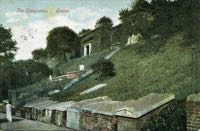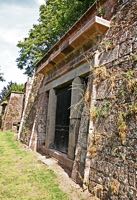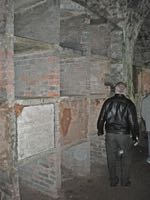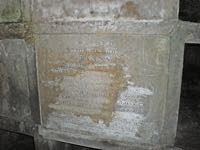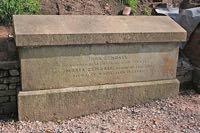
Catacombs and Lower Cemetery
Page updated 14th June 2016
Also see Exeter's Cemeteries
The Cemetery
There had been a cemetery at All Hallows (Friernhay), Bartholomew Street for 200 years, before a scheme was put forward to open the southern slope of the Longbrook Valley as an extension and to create the catacombs for the wealthy of Exeter. The growth of the city had put a strain on the existing burial grounds, and the cholera epidemic of 1832 had shown a need for new facilities, outside the city wall.
The site chosen for the new cemetery had formerly been three fields that were used for grazing. At the bottom, the Longbrook was nothing more than an open drain. James Cossins wrote of the ground:
"Before the Lower Cemetery was converted to its present use, it was three fields kept for grazing. At the bottom there was a wide open drain on the other side a succession of pigs' habitations, almost every inhabitant of Exe lane being the owner of one or two, and there being no sanitary laws the odour at times were far from agreeable."
The cemetery and catacombs were designed by Thomas Whitaker for the Improvement Commission at an estimated cost of £2,300. They were built by Henry Hooper between 1835 to 1837, at an eventual cost of £6,005. The land had cost £2,263 and the cemetery £3506.
The building works suffered many problems, including failing foundations leaving the Improvement Commission and Whitaker often in dispute. The original capacity of 1,400 interments was more than doubled when the number of catacombs was increased from 8 to 20. Dividing the catacombs and cemetery, was a wall, which survives in the cemetery, built between the Anglican and Nonconformist (Dissenters) burials, at the instigation of the Bishop of Exeter. Bishop Phillpots consecrated the Anglican cemetery 200 years from the day when Bishop Hall had opened the St Bartholomew's Cemetery. Phillpots refused to have anything to do with the Nonconformist side. Again, James Cossins wrote in 1870:
"The Lower Cemetery was consecrated by Bishop Phillpotts, August 24th, 1837, from which time to the opening of the New Cemetery in May, 1866, just 18,000 bodies were interred."
It was the first cemetery in Britain to be funded by public, rather than private funds and was opened to much public fanfare, on the 200th anniversary of the consecration of the All Hallows Cemetery above. The cost of burial in the new cemetery was 4 shillings and 6 pence (21p) which may account for events over the next fifty or so years in the catacombs.
The first burial in the new cemetery was three days after the opening, when Edward Guest, a four year old, was laid to rest in a common grave. Although the hillside of the cemetery is peppered with brick-vaulted graves and a few elaborate tombstones, the majority were buried in common graves, of which, no trace now remains. When the cemetery was eventually closed in 1949, there had been 17,552 interments.
Some interesting burials
John Dinham tea importer and philanthropist was buried on 2nd July 1864 in the Bartholomew Street Cemetery.
Samuel Wesley,
organist and
composer was buried there in 1877,
John Gendall, Exeter artist in
1865 and
William Woodbridge, miller of Cricklepit in 1879.
The Catacombs
Tucked under the city wall, the catacombs were built to accommodate 1,400 coffins in individual vaults on each side of a long, central passage. Although coffins were lowered from above to their resting place, a fine Egyptian façade was built along the front with entrances for the bereaved to enter to attend an interment. The coffin was slid into a brick lined vault while the officiating priest would conduct the service. Nearby, in a small, walled off area was a bricklayer who would wait for the end of the service, when he would then brick up the entrance. A brass plaque, or in some cases, a square stone with details of the deceased would be fixed to the bricks.
The occupants
The catacombs were also segregated into Anglican and Dissenters with an internal wall and gate across the passageway. The first occupant was Richard Every, when on the 20 July 1838, his coffin was slid into its brick lined loculi. Sepultures (internments) continued:
13 March 1841–Frances Grant
2 April 1842–Elizabeth Chamber
9 March 1844–Anne Ashe
14 January 1853–George Meyrick
Six more followed with Mrs William Penny being the last on 6 March 1883. When first opened, the charge for interment was 20 guineas, a charge which proved to be far too high, accounting for the low number of internments. Most of the occupants were from outside of Devon, as wealthy local families preferred to bury their dead elsewhere. The price was dropped to 10 and then 7 guineas, which was not enough to prevent the catacombs from being a commercial disaster. The catacombs raised £11 11s in internment fees, at a total build cost of £2,300.
The City took over the venture using the Dissenters end of the passage as a temporary morgue for the unidentified bodies from the Theatre Royal fire in September 1887. The walls of that section were covered with lime wash after the bodies were buried in Higher Cemetery. During the Second War, the cold and dark passageways were used as bomb shelters.
The stolen skeleton
The Redcoats tell the story from a few years ago, of vandals that got into the catacombs, broke into one of the individual vaults, slid out the coffin and stole the skeleton. The police, through the Express and Echo announced that the remains were likely to be infected with cholera, an invention, as cholera raged through the city five years before the catacombs were opened. Two rather chastened and white faced young men turned up at Heavitree police station complete with their find, which was presumably hastily interred, while they were hastily interned.
The structure is dank and musty with the outside wall crumbling and weeds growing out of the stonework. Inside, at the apex of the vaulted arches, engineers have fixed small glass plates which are designed to break if the structure moves – they are all broken as the massive outer wall settles, although it is not known if the catacombs are in danger of collapse. When the Redcoat tours started around about 1990, they had an open day for the catacombs when 5,000 people turned up to see the interior, as many as Exeter City would get for a league match – one wonders which was the livelier.
During the swine flu outbreak in the summer of 2009, it was reported by the Express and Echo that the City Council would use the Catacombs to store the dead from the flu, in a worst case scenario. A spokesman was quoted as saying
"As part of our overall planning for a range of possible scenarios we have looked at what we might do should the current crematorium and cemeteries within the city not be able to keep up with the need for funerals.We have some empty catacombs in an old cemetery in the city, off Bartholomew Street. These are 19th century underground burial chambers which are normally a tourist attraction. They can however be safely used for their original purpose and allow us to temporarily store bodies in the remote possibility that the need should arise."
So even in 21st Century Exeter, there may still be a need for the old catacombs to play a part in the life of the city. The catacombs can be visited with a City Redcoat guide. The cemetery and catacombs are Grade II listed, and are included in the English Heritage Register of Parks and Gardens of Special Historic Interest.
Sources: Redcoats, Express and Echo, Reminiscences of Exeter by James Cossins, the Catacombs interpretation board, and a document in the Devon Heritage Centre.
│ Top of Page │
